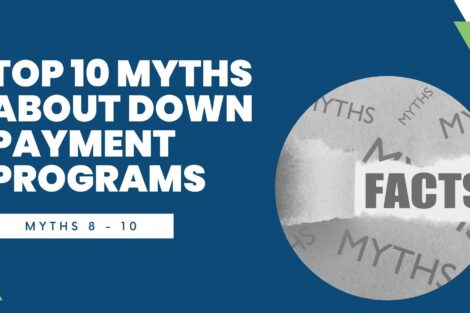
Final 3 Down Payment Program Myths Debunked

A down payment is simply the amount of cash you are putting towards the purchase of your home. For a $200,000 home, 20 percent down would be $40,000. No small amount.
Despite what you may have heard, a 20 percent down payment on a home is not necessary. Here’s why.
The myth of the 20 percent down requirement has been circulating since the housing crisis over 10 years ago. Access to credit tightened, especially for median-income homebuyers. Even responsible buyers who had the income to buy, but lacked a large down payment, faced the same challenges. Thankfully, the landscape has improved.
Low down payment options have been around for a long time. In fact, data shows that low down payment loans with sound underwriting are just as successful as loans with large down payments.
However, putting down 20 percent isn’t necessarily a bad thing. It may be the right choice for you if you have the savings as well as investments in other assets. It gives you 20 percent equity in your home and helps you avoid paying a monthly fee for private mortgage insurance.
At the same time, saving for 20 percent is keeping many buyers on the sidelines. Plus, high demand is rapidly increasing home prices, making it harder and harder to save for that down payment. The goal posts keep moving while you’re trying to do all the right things.
There are plenty of ways for buyers to make themselves more competitive in a tight market. One is using a low down payment loan, along with down payment assistance. This way, you can leverage and diversify your other investments so all your money isn’t in one asset—your home.
Wait and save. Just keep in mind that it’s estimated to take 14 years or more for a homebuyer to save for a 20 percent down payment. That’s more than 14 years for your rent, home prices, and interest rates to rise, too. And 14 years later, you’ll have zero equity in a home, wiping out yours and your next generation’s wealth-building potential.
Find a homeownership program. The majority of homeownership programs provide down payment and closing cost assistance, helping finance some or all of your costs. There are nearly 2,300 homeownership programs available across the country, including grants, forgivable loans, below-market first mortgages, tax credits and more.
The average down payment program benefit across all programs is more than $7,500. Both the home and the homebuyer must qualify for the program so do your research early.
Use a low down payment mortgage. There are several options for buyers today. Keep in mind that you can layer down payment programs with these loans.
For home loans, there’s not a “one size fits all” or right choice for everyone. Like you, your finances and home buying goals are unique. That’s why it’s important to lock up your home financing before you tour that dream home.
Begin by investigating your options early: talk to multiple lenders, search for homeownership programs, and talk to your real estate agent.
Do you have a low down payment story to share? We’d love to hear about your experience.
Never want to miss a post? For more useful down payment and home buying information, be sure to subscribe to our mailing list.
Are you an industry professional? Download our latest Down Payment Report for the data and news on first-time homebuyers and residential down payments.
